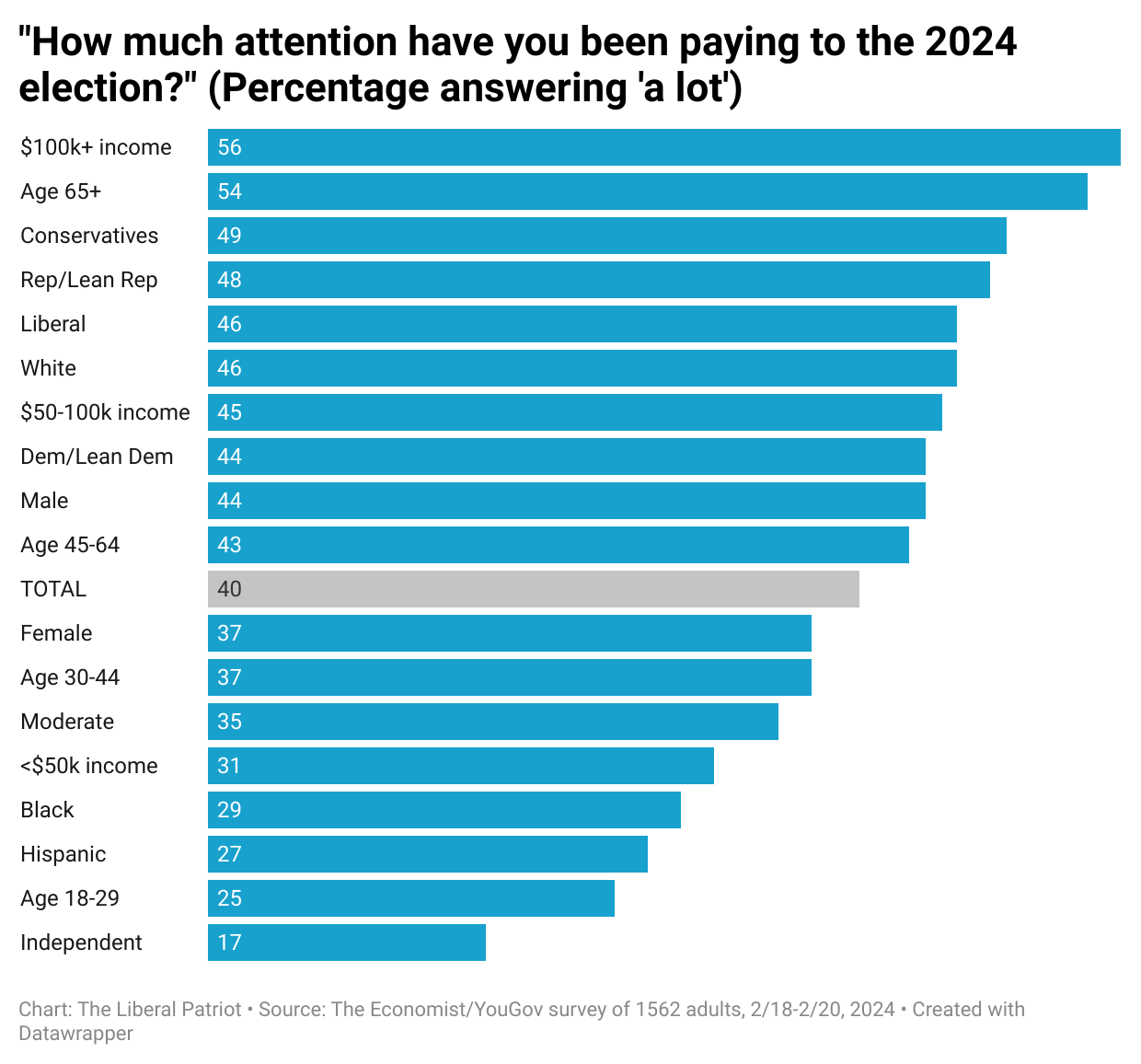
For the 2024 horse race polls to have any real credibility this far out, you need to have some confidence that most Americans are paying attention to the race otherwise you’re measuring the opinions of the most engaged voters and getting mere inclinations from everyone else.
But according to the most recent data from The Economist/YouGov, the opposite is true—most Americans report that they are not paying close attention to the 2024 election at this stage.
As the chart below highlights, only 40 percent of American adults overall report that they have been paying a lot of attention to the 2024 election, with 31 percent paying some attention and 28 percent paying only a little or no attention at all. Even among registered voters, only half report paying a lot of attention to the election.
There are notable demographic and ideological attention gaps that emerge in these data.
For example, the wealthiest and oldest Americans report the highest levels of attentiveness to the 2024 election with 56 percent of those earning $100,000 or more in household income, and 54 percent of those ages 65 or older, saying they’ve been paying a lot of attention to race. Conservatives and liberals, self-identified members of both parties, whites, and males also report above average attentiveness.
In contrast, younger Americans, women, blacks, Hispanics, low-income adults, and ideological moderates all report lower than average attentiveness to the election—ranging from 25 to 37 percent saying they’ve been paying a lot of attention.
Most importantly, strict independents (those who do not identify with or lean towards either Democrats or Republicans) report the lowest levels of attentiveness to the race of any demographic or partisan group: Less than one fifth (17 percent) of political independents say they’ve been paying a lot of attention to the 2024 election.
Why does this matter?
The race is very tight in current national polling, with Donald Trump holding small leads in many polls, including this current Economist/YouGov poll (43 percent Trump, 42 percent Biden, 6 percent other, 5 percent not sure, 4 percent would not vote), and Joe Biden holding equally small leads in others.
According to these data, the people paying the most attention to the race are more ideological and partisan voters along with demographic groups with the highest propensity to vote and participate in politics, such as older and wealthier people. These engaged Americans seem split.
On the other side of the attention gap, the people giving the least amount of consideration to the race include groups such as younger people, non-whites, and moderates that currently trend toward Biden but also tend to be less likely to vote or to follow politics more generally.
Should these groups become more engaged in the race over time, and more importantly, increase their likelihood of both supporting President Biden and turning out to vote this fall, the president and his team should feel good about his chances. Alternatively, should members of these groups continue to be uninterested in the election—or more worryingly for Democrats, start to split in their evaluations of the two candidates—Trump and his team should like their chances.
Among the less attentive cohort, political independents are the only group trending toward Trump (34 percent Trump, 23 percent Biden, 18 percent other, 11 percent not sure, and 15 percent not planning to vote in The Economist/YouGov poll). Should this group increase its engagement and commitment to him as the election nears—and critically actually turn out to vote this November—the former president and his team will feel good about their potential to eke out a narrow victory. Alternatively, if these independent Americans decide to check out from the election, or break more towards Biden over the next few months, the president’s re-election bid looks more solid.
Given these dynamics, it would make sense for both campaigns to focus less on catering to the most engaged and ideological voters in the electorate and spend more time defining a concrete agenda that meets the needs of more normal and moderate Americans—and perhaps persuade these potential yet currently tuned out voters to give them a serious look in 2024.




